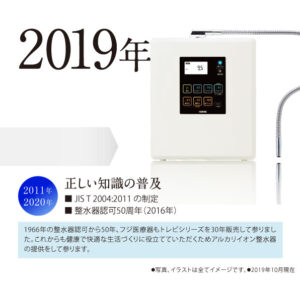A Comprehensive History of Electrolyzed Reduced Water (Alkaline Ionized Water) in Japan
The story of electrolyzed reduced water, also known as alkaline ionized water, spans nearly a century. From early scientific curiosity and grassroots enthusiasm to medical recognition and consumer products, Japan’s journey with ionized water is both compelling and scientifically grounded. Fujiiryoki’s pioneering 1989 home-use ionizer brought this technology from niche clinics into households—a turning point we explore here in context with the broader scientific advances tracked by the Association of Alkaline Ionized Water Apparatus (3AAA).
Early Beginnings: Showa Era Experiments (1930s–1950s)
Circa 1930: Enthusiasts began to believe in the curative potential of “electrolyzed water.”
1952–1954: Michisue Suwa, a researcher with Synnohl Electric Machinery, developed the first electrolysis equipment—then called “Synnohl liquid.” Working with Tokyo University’s Professor Akiba, Suwa explored both agricultural applications and early healthcare potentials. At this stage, water electrolysis was tested in rice cultivation to improve growth through water quality control. (Source: 3AAA)
1955 (Showa 30): A wave of interest in alkaline ionized water emerged, with particular popularity among police officers intrigued by its purported health benefits.
Medical Approval & Practical Use (1960s–1980s)
1960s: The Synnohl Liquid Medical Science Research Association was formed, reflecting a shift from agricultural use toward therapeutic applications. (Source: 3AAA)
1965 (Showa 40): The Ministry of Health and Welfare officially recognized alkaline water generators as medical devices under the Pharmaceutical Affairs Law (Notice No. 763). Approved benefits included relief for indigestion, chronic diarrhea, hyperacidity, and abnormal fermentation of the gastrointestinal tract. Acidic water, on the other hand, was recognized for its astringent properties. (Source: 3AAA)
1979: Continuous-flow alkaline ionized water generators were approved for direct connection to tap water—leading to the official use of the term “alkaline ionized water.” (Source: 3AAA)
1985 (Showa 60): At Kyowa Hospital, Dr. Munenori Kawamura and Dr. Hidetaka Shinohara initiated treatments of chronic diseases without pharmaceuticals, instead utilizing electrolyzed reduced water.
1989 (Heisei 1): A milestone year—Fujiiryoki launched Japan’s first home based alkaline water ionizer, expanding access from hospitals and labs to everyday households. (Source: Fujiiryoki)
Mainstream Exposure & Scientific Rigor (1990s)
1992 (Heisei 4): Nippon TV aired “Amazing Water”, presenting compelling clinical cases such as improvements in diabetic foot complications. Public curiosity soared, and medical interest deepened.
1993: In response to growing attention, the Association of Alkaline Ionized Water Apparatus (3AAA) was established. Its mission: to regulate standards, verify safety, and coordinate scientific research. (Source: 3AAA)
1994: The first Functional Water Symposium was held at Makuhari Messe, marking the start of an annual gathering for researchers, physicians, and manufacturers.
1993–1997: The Alkaline Ionizer Review Committee, chaired by Professor Itokawa, confirmed safety and effectiveness. Double-blind clinical trials were initiated, and by 1999, the world’s first double-blind drinking-water trial validated alkaline ionized water’s therapeutic benefits for gastrointestinal health. (Source: 3AAA)
Continued Research & Industry Standards (2000s–Today)
2001: Research demonstrated that electrolyzed reduced water enhances glucose uptake in muscle cells, suggesting potential antidiabetic benefits.
2003: Discovery that platinum nanocolloids in electrolyzed water act as active hydrogen donors, offering possible antioxidant effects. the importance of hydrogen plus alkaline ionized water.
2005: Under revisions to the Pharmaceutical Affairs Law, alkaline ionizers were formally positioned as household-use control medical devices. The JIS-T 2004 standard was enacted to ensure safety and effectiveness for consumer use. (Source: 3AAA)
Present Day: Annual symposiums continue under the joint leadership of 3AAA and the Functional Water Foundation, exploring the physiological effects of electrolyzed reduced water across digestive health, metabolic support, and antioxidation research.
Summary Timeline
| Period | Key Milestones |
|---|---|
| 1931–1950s | Early research (Synnohl liquid); agricultural trials |
| 1965 | Ministry approval as medical device |
| 1979 | Continuous tap-connected generators approved |
| 1985 | Kyowa Hospital trials with reduced water |
| 1989 | Fujiiryoki (Fuji Medical Instruments mfg co., ltd) launches first home based alkaline ionizer |
| 1992–1997 | Media spotlight, 3AAA founding, clinical validations |
| 2005 | Household-use medical device certification under JIS-T 2004 |
| 2005–Present | Ongoing symposiums, industry regulation, global interest |
In acquiring an authentic Japanese alkaline water ionizer, one is not simply investing in technology, but in a proven heritage of engineering, trust, and long-term value. Backed by decades of scientific progress and uncompromising Japanese standards, it represents more than a product—it is a strategic choice for health, reliability, and sustainable wellness.

